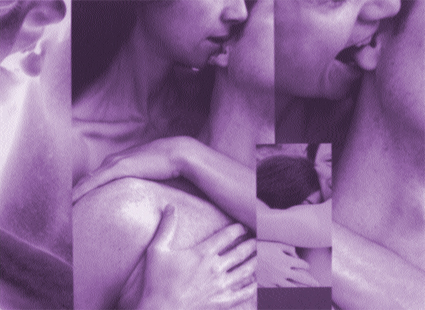In the body of the work
Zsuzsanna Soboslay and Tim Moore in rehearsal for the premiere of the movement opera Awakenings talk to Keith Gallasch

Zsuzsanna Soboslay and Benjamin Howes, Awakenings
photo Tim Moore
Zsuzsanna Soboslay and Benjamin Howes, Awakenings
Well into rehearsal, I ask the conceiver-performer of Awakenings, Zsuzsanna Soboslay, is it the envisaged work that is emerging? She explains that the structure is becoming more overt, “a good thing, the outward shape, but I’m waiting for the interior to re-emerge, the inflections in the body that the work began with. They’re coming”. This waiting happens to most of us to some degree mid-rehearsal process, but food-poisoning in Istanbul over two months ago on the way to LIFT97 in London, has left her asking “Is this my body?” and querying judgments made in response to it in rehearsal. She seems confident nonetheless that the body, and the vision of the show with it, is there.
I ask designer Tim Moore if the set’s evolution has been subject to transformations. He explains that the set was ready for the first day of rehearsals so that the performers could live with and learn it, especially given that “it has a life of its own, has four or five actions—parts of it slide up and down, it revolves, has at least two levels to work on physically and is both reflective and transparent”. The initial inspiration came from a workshop two years ago at the Centre for Performance Studies at Sydney University and from Frank Wedekind’s Spring Awakening, the German classic of thwarted and brutalised child-innocence which has inspired Zsuzsanna’s Awakenings. This is a set then that is expressionist in impulse, a device of discovery and grim witnessing, a window on a child’s world, “a massive window which is also a door”. “It’s monolithic,” says Moore, “but now I’ve disappeared it a bit, changed the surfaces—you can see it and see into it. Originally it was a staircase on wheels but it’s transformed into a room that can become a cage, a space for the performers to discover things, with room to move”.
Zsuzsanna comments that the set has provided “landscapes, corridors, circles, a sense of window and horizon”, that the capacity of the set to revolve has enhanced the relationship between the performers; the way a door turns helps realise the transformation in one character oscillating between mother and daughter roles, amplifying swings between innocence and knowledge, showing what gets hidden, what disappears.
Complete as the set is in construction and in its life in rehearsal with the performers, it awaits the transformations of light and video projection. The latter, as often, is quite a design challenge, having to find the right surface to project on, where to place the images, and how to make them complementary or counterpoint to the set and the action, not a distraction. This is especially the case, says Zsuzsanna, when the images are about “going inside memory, into the body”. Already the scale of the set and its proximity to the audience will amplify their own recollections of innocence and awe. The video imagery will take them further in and back, but with its own dynamic and in relation to what’s happening live: “A soft-shoe dance on video”, says Zsuzsanna, “doesn’t yearn, but the accompanying song does”. The challenge of the meeting of live and recorded actions and of creating a soft surface to hold projected images clearly preoccupy the thoughts of Awakening’s creators at this stage of the work’s development.
As does the music. “Sound”, Zsuzsanna retorts. “We might have started with Schoenberg, but save a brief quotation, his music is not in the show. We don’t have big slabs of music from the late 19th century, early 20th (Spring Awakening was published in 1892). It’s in our bodies, the music is ours, in our movement. We are aware of sources of sound—the pulse of nursery rhymes, marches, beer hall songs; these melodies can block out other, earlier melodies.”
The sound score for Awakenings is being created by sound artist Rod Berry and is about to enter rehearsal with its own vocabulary for the performers and the set to work and live with. It’s a process in which “movement can evolve into sound, sound into movement”. “Rod will create sounds around the silences. He won’t fill the space. He’ll make the blackboard and different parts of the set speak. Sound helps one travel in time, shifts you historically, for example as a performer transforms from youth to crone; sound can demonstrate time as contiguous—the past and present in one moment.”
This moment, for Zsuzsanna and Tim, is one such combination of past—the inspiration of Wedekind, the seminal workshop of some two years ago, the recent creation of the set—and present—living in the set, working with projected images and sound, the interior of the work re-emerging and, doubtless, transforming. Awakenings is about change: “Change comes from vulnerability. Change comes from desire. Can a culture change when it holds fiercely to its identity and power?”
Awakenings, conceived, written and performed by Zsuzsanna Soboslay, with Benjamin Howes; sound, Rod Berry; images, Peter Oldham, Alan Dorin; set, Tim Moore; lighting, Peter Gossner. The Performance Space, Sydney, August 14-24
RealTime issue #20 Aug-Sept 1997 pg. 38






